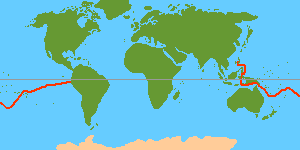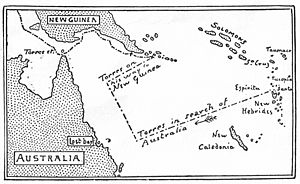Luís Vaz de Torres facts for kids
Luís Vaz de Torres was a brave explorer from Spain who sailed the seas in the late 1500s and early 1600s. He is famous for being the first European to sail through the narrow waterway between Australia and the island of New Guinea. This important strait is now named after him: the Torres Strait.
Contents
Who Was Luís Vaz de Torres?
Luís Vaz de Torres was born around 1565 in Galicia, a region in northwest Spain. Some old records from his voyages mention him as a "Breton," which points to his Galician roots. We don't know the exact date or place of his birth.
Torres joined the Spanish navy and traveled to the Spanish territories in South America. He first became known when he was chosen to be the commander of the second ship in an expedition across the Pacific Ocean. This journey was led by a Portuguese navigator named Pedro Fernandes de Queirós, who was searching for a large southern land called Terra Australis. There are no pictures of what Torres looked like.
The Queirós Expedition
Pedro Fernandes de Queirós led three Spanish ships: the San Pedro y San Pablo, the San Pedrico, and a smaller boat called Los Tres Reyes Magos. Torres was in charge of the San Pedrico. The ships left Callao in Peru on December 21, 1605.
In May 1606, they found a group of islands that are now known as Vanuatu. Queirós named them La Austrialia del Espiritu Santo, meaning "Austrialia of the Holy Spirit." The largest island in Vanuatu is still called Espiritu Santo. This name, along with the old Latin name Terra Australis, helped inspire the name for Australia.
After six weeks, the ships sailed again. On June 11, 1606, Queirós's ship, the San Pedro y San Pablo, got separated from the others during bad weather. Queirós later said he couldn't return, but it seems his crew actually mutinied. The captain of Queirós's ship, Don Diego de Prado, and the expedition's doctor had already moved to Torres's ship because they knew about the crew's plans. Queirós's ship then sailed to Acapulco in Mexico. Torres later wrote that Queirós's ship left on purpose, saying they "did not sail on the proper course, nor with good intention."
Torres Takes Charge
Torres stayed at Espiritu Santo for 15 days. He then opened secret orders from the Viceroy of Peru. These orders explained what to do if the ships got separated and who would be in charge if Queirós was lost. Torres took command of the remaining two ships.
Exploring New Guinea and Torres Strait
On June 26, 1606, Torres and his ships, the San Pedrico and Los Tres Reyes Magos, set sail for Manila. Strong winds stopped them from taking the direct route along the north coast of New Guinea. Instead, they sailed along the southeastern coast.
They saw land on July 14, 1606, which was likely Tagula Island. Over the next two months, they explored the coast, stopping often to get food and water. They discovered Milne Bay and Basilaki Island, which they claimed for Spain. During this time, they met local people, and there were some conflicts.
Torres then sailed into the Gulf of Papua, mapping the coastline. He then took a route close to the New Guinea coast to sail through the Torres Strait, which is about 150 kilometers (93 miles) wide. It is now named after him. Some experts believe Torres might have sailed through a nearby channel called Endeavour Strait. From there, he would have seen Cape York Peninsula, the northernmost tip of Australia. This means Torres saw Australia without realizing it!
Torres continued along the New Guinea coast and claimed the island for the King of Spain on October 18, 1606. He reached the western end of New Guinea on October 27. He then sailed north towards the Spice Islands (now part of Indonesia). In January 1607, he reached Ternate. He sailed on to Manila, arriving on May 22. His journey proved that New Guinea was not part of the large southern continent that explorers were looking for.
What Happened After the Voyage?
Torres wanted to go back to Spain to tell the king about his discoveries. However, officials in Manila needed his ships and crew for other duties.
On June 1, 1607, Queirós's old ship arrived in Manila. Torres learned that Queirós was alive and immediately wrote a report of his voyage to him. Torres, his crew, and the people they had taken from New Guinea then disappear from history. We don't know what happened to them next.
Most of the documents about Torres's discoveries were not published right away. They were stored in Spanish archives. Many years later, between 1762 and 1765, a British mapmaker named Alexander Dalrymple found these accounts. He shared this information with Joseph Banks, who likely passed it on to Captain James Cook. This information helped later explorers.
The original official report of Torres's voyage was bought by the State Library of New South Wales in Australia in 1932. It was shown to the public for the first time in 1997.
Records of the Journey
Several important documents describe the voyages of Queirós and Torres:
- Queirós wrote many letters to King Philip III of Spain about the journey.
- Torres wrote a short report to the king in July 1607.
- Diego de Prado wrote a detailed story called Relacion Sumaria in 1608, which included four maps of New Guinea.
These records helped people in later centuries understand the important discoveries made by Luís Vaz de Torres.
See also
 In Spanish: Luis Váez de Torres para niños
In Spanish: Luis Váez de Torres para niños
- European maritime exploration of Australia



